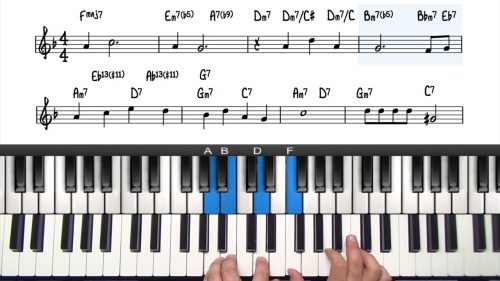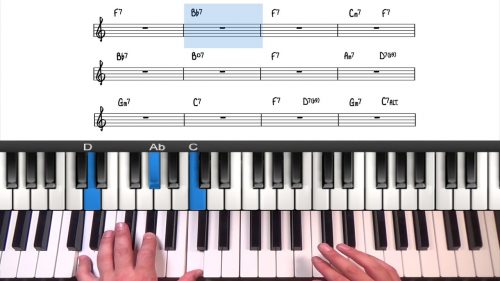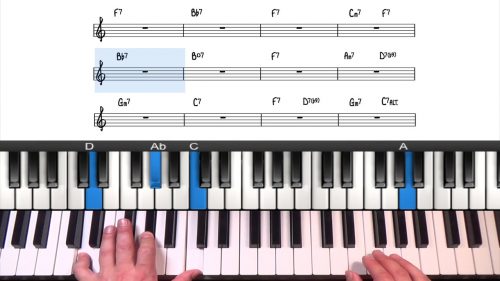Embellishing The Melody
In the previous lessons we have explored the basic harmony of the tune “Georgia” and we introduced a simple stride left hand style to outline the quarter beat pulse of the tune.
In this lesson we are going to focus on the melodic aspects of arranging the tune. We will take each bar of the A Section and apply licks, fills, and melodic ornamentation that we can use to create a soulful bluesy vibe.
The Melody As The Basis For Improvisation
A good starting point for beginner improvisers is to take the melody of the tune and use this as the primary source of inspiration to find and develop melodic ideas. In this lesson we explore 5 different melodic devices that we can use in our improvisations.
Using Grace Notes
Grace notes are used primarily for decorative purposes, in particular to add interest to a musical passage. Grace notes are usually very quick and brief and they are used as an ornamentation for the note that follows.
One of the limitation of the piano is that we cannot bend the notes. The closest way that we can achieve this on the piano is to use grace notes and this blurs the distinction between the notes to create a human & soulful aspect.
In this lesson we explore 3 types of grace notes, half step, whole step, and double or triple grace notes.
Blues Scale Walkups
Walking up fragments of the blues scale can be an effective way to fill in the space and add interest when approaching the melody notes. This can be combined with grace notes to create soulful and bluesy fills when the melody is static.
When adding blues scale fragments, always keep in mind the points of resolution in the melody of the tune. A good example of this is the note “A” over the Fmaj7 chord (the first chord of the A Section). “A” is a primary chord tone of the Fmaj7 chord and we can use approach patterns and enclosures to connect our melodic decoration back to the main melody of the tune as demonstrated in this tutorial.
In the next module we are going to learn the bridge of the tune, we will explore some new voicing techniques, and we will introduce 10th intervals in the left hand.
Lesson Downloads
-
Licks & Riffs Notation File Type: pdf
Practice Tips
-
Practice these bluesy fills and try to take the concepts to create your own bluesy embellishments and decoration.
-
Always keep in mind a point of resolution to resolve your fills and melodic embellishments.
-
Remember that all of these embellishment concepts work together and can be combined to create soulful bluesy fills and decoration.








Any chance you could write out the notation for these blues licks? Maybe in 2 or 3 keys. I think it would help immensely.
Hi Wendy,
Great idea yes i will add some additional notation. I will reply to your comment once the notation is added.
Cheers,
Hayden
Hi Wendy,
I have just added the notation for all of the lessons this course.
Apologies for the delay!
Cheers,
Hayden
Can you give the correct fingerings for F maj pentatonic scale please. I want to get it under my fingers but don’t want to learn the incorrect fingering. Thx
Hi James 👋
Yes I can help out here.
My view is that it’s better for you to learn the fingering for the major blues scale which we are using in this lesson. This is just the pentatonic scale but with the b3 added in.
For the F Major Blues Scale we have the following notes:
F-G-Ab-A-C-D
I would fingering this as:
F(1)-G(2)-Ab(3)-A(1)-C(2)-D(3) and the pattern starts again.
Understand that we running up and down scales in improvisation can sometimes be okay, but it’s much better to change the ‘step-wise sequence’, repeat notes, create motifs, add grace notes etc…
To learn the scale I understand that it’s good to have a set fingering, but remember that if we just practice the scale moving up and down the scale tones sequentially with the same fingering, then it sounds very 1-dimensional.
The next important point is the relative major and minor blues scale.
Remember from our lessons in the foundations course that every major scale has a relative minor scale. This is the same for the blues scales, and so if we play the F Major Blues scale from D to D, we then have the D minor blues scale.
For this I would finger it as:
D(1)-F(2)-G(3)-Ab(4)-A(1)-C(2) and then the pattern starts again.
You might like to check out the following lessons to better understand this relationship:
https://www.pianogroove.com/blues-piano-lessons/the-major-blues-scale/
https://www.pianogroove.com/jazz-piano-lessons/ballad-blues-scales-licks/
Finally, don’t always start the major blues scale on the root (F), particularly over the F major chord, as this will sound a little plain. This is why visualising the D minor blues scale can work well.
Also study the lessons in this course on blues licks and you will find lots more creative ways to use the major blues scale.
I hope that helps James and let me know if you have any further questions.
Cheers,
Hayden